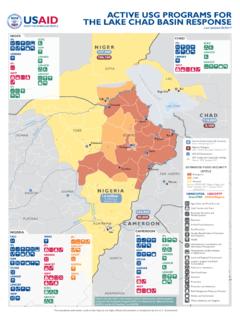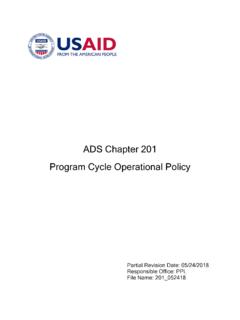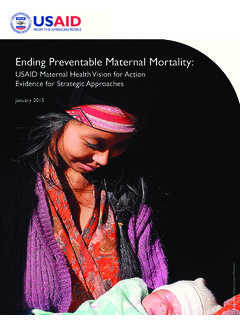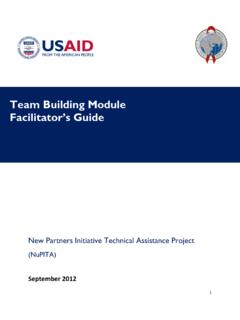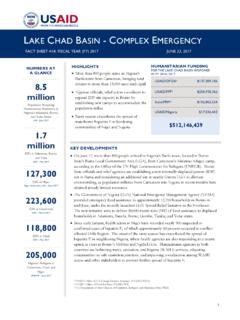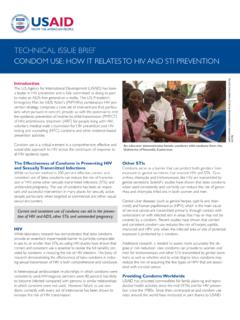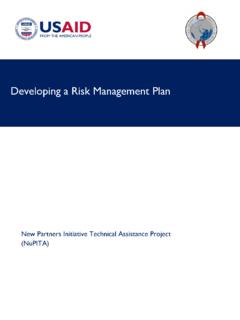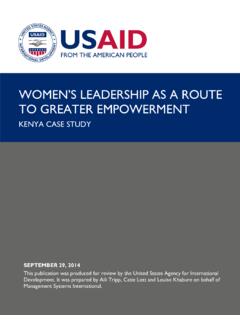Transcription of USAID BUREAU FOR HUMANITARIAN ASSISTANCE …
1 BHA Indicator Handbook Page 0 PHOTO CREDIT: USAID USAID BUREAU FOR HUMANITARIAN ASSISTANCE INDICATOR HANDBOOK FOR EMERGENCY ACTIVITIES July 2020 BHA Indicator Handbook Page 1 TABLE OF CONTENTS ACRONYMS AND ABBREVIATIONS 2 INTRODUCTION 5 HOW THIS HANDBOOK IS ORGANIZED 5 INDICATOR NUMBERS 6 APPLICABILITY CRITERIA 7 KEY TERMS AND DEFINITIONS 8 DISAGGREGATION AND REPORTING 11 DATA COLLECTION METHODS 11 LIFE OF AWARD (LOA) VALUES 13 PERFORMANCE INDICATOR REFERENCE SHEETS - FOOD SECURITY 15 PERFORMANCE INDICATOR REFERENCE SHEETS - BY SECTOR 29 AGRICULTURE 29 DISASTER RISK REDUCTION POLICY AND PRACTICE 78 ECONOMIC RECOVERY AND MARKET SYSTEMS 110 FOOD ASSISTANCE 133 HEALTH 143 HUMANITARIAN COORDINATION AND INFORMATION MANAGEMENT, AND ASSESSMENTS 198 HUMANITARIAN POLICY, STUDIES, ANALYSIS, OR APPLICATIONS 222 LOGISTICS 223 MULTIPURPOSE CASH ASSISTANCE 234 MONITORING AND EVALUATION 258 NUTRITION 259 PROTECTION 289 SHELTER AND SETTLEMENTS 300 NATURAL HAZARDS AND TECHNOLOGICAL RISKS 328 WATER, SANITATION.
2 AND HYGIENE 345 PERFORMANCE INDICATOR REFERENCE SHEETS - KEYWORD INDICATORS 441 PERFORMANCE INDICATOR REFERENCE SHEET TEMPLATE FOR CUSTOM INDICATORS 448 BHA Indicator Handbook Page 2 ACRONYMS AND ABBREVIATIONS ANC Antenatal Care ARI Acute Respiratory Infection BCC Behaviour Change Communications BEMONC Basic Emergency Obstetric and Newborn Care BHA BUREAU for HUMANITARIAN ASSISTANCE CAHW Community-Based Animal Health Worker CALP Cash Learning Partnership CBO Community-Based Organization CFR Case Fatality Ratio CFW Cash for Work CHW Community Health Worker CMAM Community Management of Acute Malnutrition CMR Clinical Management of Rape CNA Child No Adult CSB+ Corn Soy Blend Plus DHS Demographic and Health Survey DRM Disaster Risk Management DRR Disaster Risk Reduction EML Essential Medicines List EMONC Emergency Obstetric and Neonatal Care EPI Expanded Program of Immunizations ERMS Economic Recovery and Market Systems EWARN/S Early Warning and Response Network/Systems FBF Fortified Blended Food FCS Food Consumption Score FGD Focus Group Discussion FNM Female No Male FRC Free Residual Chlorine F&M Female and Male GAM Global Acute Malnutrition GBV Gender-Based Violence GIS Geographic Information System GMP Growth monitoring and promotion HA HUMANITARIAN ASSISTANCE HCIMA HUMANITARIAN Coordination, Information Management, and Assessments HF Health Facility HH Household HHS Household Hunger Scale BHA Indicator Handbook Page 3 HHWT Household Water Treatment HP HUMANITARIAN Partner HPSAA HUMANITARIAN Policy, Studies, Analysis, or Applications HVCA Hazard, Vulnerability and Risk Capacity Assessment IDP Internally displaced person IEC Information, Education.
3 Communication IFA Iron and Folic Acid IMCNI Integrated Management of Childhood and Neonatal Illness IP Implementing Partner IPC Infection Prevention and Control ITM Insect-Treated Materials ITPS Insect-Treated Plastic Sheeting ITT Indicator Tracking Table IYCF Infant and Young Children Feeding KAP Knowledge, Attitude and Practice KG Kilogram KII Key Informant Interview LCS Livelihood Coping Strategy LLIN Long-lasting insecticide-treated net LNS Lipid-based Nutrient Supplement LOA Life of Award MAM Moderate Acute Malnutrition MDD-C Minimum Dietary Diversity - Children MDD-W Minimum Dietary Diversity - Women M&E Monitoring and Evaluation MEB Minimum Expenditure Basket MFI Microfinance Institution MHM Menstrual Hygiene Management MISP Minimum Initial Service Package MNF Male No Female MNP Multiple Micronutrient Powder MOH Ministry of Health MPCA Multipurpose Cash ASSISTANCE MSE Micro and Small Enterprise MT Metric Ton MUAC Mid-Upper Arm Circumference M&E Monitoring and Evaluation NCD Non-Communicable Disease NFI Non-Food Item NGO Non-governmental organization BHA Indicator Handbook Page 4 ODF Open Defecation Free ORI Outbreak Response Immunizations ORS
4 Oral Rehydration Salts OTP Outpatient Therapeutic Feeding Program PDM Post-Distribution Monitoring PHC Primary Health Care PIO Public International Organization PIRS Performance Indicator Reference Sheet PLW Pregnant and Lactating Women PNC Postnatal Care POU Point of Use R Required RH Reproductive Health RiA Required if Applicable rCSI Reduced Coping Strategies Index ROSCA Rotating Credit and Savings Association RUSF Ready-To-Use Supplementary Food RUTF Ready-To-Use Therapeutic Food S&S Shelter and Settlements SBC Social Behavior Change SC Stabilization Center SDB Safe and Dignified Burial SFP Supplementary Feeding Program SILC Savings and Internal Lending Communities SIS Supplemental Immunization Activities SMART Standardized Monitoring and Assessment of Relief and Transitions SPS Standardized Program Structure STI Sexually Transmitted Infection TB Tuberculosis TPM Third party monitoring VIP Ventilated Improved Pit Latrine VSLA Village Savings and Loan Association WASH Water, Sanitation and Hygiene WFP World Food Program WHO World Health Organization WHZ Weight-for-height z score WSP Water Safety Plan BHA Indicator Handbook Page 5 INTRODUCTION The USAID BUREAU for HUMANITARIAN ASSISTANCE Indicator Handbook for Emergency Activities provides guidelines for tabulating and reporting on emergency activities funded by the USAID BUREAU for HUMANITARIAN ASSISTANCE .
5 The handbook is intended to be used by applicants and implementing partners. This handbook contains performance indicator reference sheets (PIRS) for all BHA indicators, guidance on applicability criteria for each indicator, and guidance on what partners should include in custom indicator PIRSs. Each PIRS describes: key terms in each indicator; how the indicator should be calculated; how disaggregates should be reported; how the data should be collected; and any additional, external resources that may be useful for understanding how to use the indicator in practice. HOW THIS HANDBOOK IS ORGANIZED This handbook contains 5 sections. This introductory section, Section 1, provides important information about how to use this handbook and how common terms used across many PIRSs are defined. Sections 2 through 4 include the PIRSs for all BHA indicators and summary tables that explain which indicators should be used in each sub-sector or for activities with a Food Security goal/purpose.
6 Section 2 includes a summary table of indicators that partners should use for activities with a Food Security goal or purpose, as well as PIRSs for 4 indicators. Section 3 includes 15 sub-sections one for each of the BHA sectors which are organized alphabetically from Agriculture to WASH. Section 4 includes PIRSs for Keyword indicators that are not affiliated with a specific sector. Several BHA indicators are used in several sub-sectors and/or Food Security. These indicators are listed under each sub-sector summary table, along with their applicability criteria and preferred method of data collection. The full reference sheet for each indicator, by contrast, only appears once in the handbook: it is located in the section/sub-section where that indicator is most likely to be used/referenced most often by partners. Partners should use the summary tables at the beginning of each chapter to toggle to the correct page(s) where the PIRS is located, , using the hyperlink or page number in the summary table.
7 BHA Indicator Handbook Page 6 Table 1 summarizes the total number of unique PIRSs that appear in each sub-sector, as well as the total number of indicators included under that sub-sector. (Note that Food Security and Keywords are not sub-sectors, but rather stand-alone sections in this handbook.) Table 1. List of Indicator Totals by Sector Sector/Sub-Sector* Unique # of PIRS within Section Total # of Indicators Food Security 4 4 Agriculture 24 27 Disaster Risk Reduction Policy and Practice 16 16 Economic Recovery and Market Systems 12 12 Food ASSISTANCE 4 18 Health 27 28 HUMANITARIAN Coordination, Information Management, & Assessments 13 13 HUMANITARIAN Policy, Studies, Analysis, or Applications (HPSAA) ** ** Logistics 4 4 Monitoring and Evaluation (M&E) ** ** Multipurpose Cash ASSISTANCE 10 12 Nutrition 13 13 Protection 6 6** Shelter and Settlements 13 13 Natural Hazards and Technological Risks 8 8 Water, Sanitation, and Hygiene 42 42 Keywords: cash and vouchers 3 3 Totals 199 219 *Note that Food Security and Keyword are not sectors, but partners should refer to the section summary tables for specific indicator requirements.
8 **Note that there are no standard BHA indicators for the HPSAA or M&E sectors, however, partners should refer to those sections respective summary tables for sector-specific indicator requirements. **The Protection sector requires additional, custom indicators in addition to the 6 Required indicators. Finally, Section 5 includes an annotated PIRS template that partners should use when creating custom indicator PIRSs. Partners are encouraged to use the PIRS template provided in this handbook, but may use other formats as long as the required information is included. BHA Indicator Handbook Page 7 INDICATOR NUMBERS Each BHA indicator has a unique, alphanumeric identifier. All Food Security indicators are identified by FS plus a number ( , FS1, FS2, FS3). All sector indicators are identified by a single letter plus a number ( , Health indicators are H1, H2, H3). Keyword indicators are identified by the letter K followed by a number.
9 Table 2 outlines the lettering system used to identify BHA indicators. Table 2. Alphabetic Numbering System for BHA Indicators FS Food Security A Agriculture D Disaster Risk Reduction Policy and Practice E Economic Recovery and Market Systems F Food ASSISTANCE H Health I HUMANITARIAN Coordination, Information Management, & Assessments L Logistics M Multipurpose Cash ASSISTANCE N Nutrition P Protection S Shelter and Settlements T Natural Hazards and Technological Risks W Water, Sanitation, and Hygiene K Keywords: cash and vouchers Note: The sectors HUMANITARIAN Policy, Studies, Analysis, or Applications (HPSAA) and Monitoring and Evaluation (M&E) are not included above as all of the required indicators for those sectors are custom. Partners should use the letter C to designate custom indicators within their Indicator Tracking Table For example, if a partner uses three customer indicators, they should number these as C1, C2, and C3, respectively.
10 The partner should create a PIRS for each custom indicator, and include the unique indicator number at the top of the PIRS. Section 5 includes an annotated PIRS template that partners should use when creating custom indicator PIRSs. BHA Indicator Handbook Page 8 APPLICABILITY CRITERIA Each PIRS, and the summary table at the top of each section, identifies the applicability criteria for each indicator or sub-sector. Most sectors designate indicators as either required (R) or Required if Applicable (RiA). Required indicators must be collected and reported on within that sector or sub-sector. Required if Applicable indicators must only be collected and reported on if the applicability criteria articulated in the PIRS is met. Some sub-sectors use a different system for applicability criteria whereby partners need to pick a Required, Required if Applicable, and either Select 2 or Select 3.
